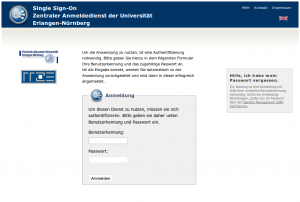English Version
Seit März ist eine Weile vergangen und wir konnten mit FAU.ORG weitere Erfahrungen sammeln.
Auf der Agenda stand der große Punkt “Ausgabe der Daten für Menschen”, sprich die Informationen in FAU.ORG sollten irgendwie in eine Form gebracht werden, dass Menschen die Informationen direkt verwenden können. Bisher gab es dafür nur die Export Funktion aber deren Ergebnisse erforderten eine wie auch immer geartete Aufbereitung. Mit diesem Release hat dieser Missstand ein Ende!
Das Druckende
Mit dieser Version von FAU.ORG haben Sie die Möglichkeit Informationen direkt aus der Anzeige in Ihrem Browser auszudrucken.
Hierfür wurden die Seiten:
- der Baum
- Organisationseinheiteninformation sowie
- Liste der Suchergebnisse
entsprechend angepasst. Alle anderen Seiten wurden vom Produktbesitzer als “nicht druckrelevant” eingestuft. Sollten Sie dennoch einen Bedarf sehen, freuen wir uns auf Ihre Hinweise an fau.org-support@rrze.uni-erlangen.de.
Das Berichtende
Die Spezifikation sieht vor, dass es einen offiziellen Organisationsplan sowie einen internen mit zusätzlichen Informationen geben soll. So wird die offizielle Version nur öffentliche Organisationseinheiten enthalten, während die interne Version auch inoffizielle Organisationseinheiten liefern wird.
So finden Sie nun im Menü auf der rechten Seite den Punkt “Berichte”.
Allerdings wird dieser noch keine aufrufbaren Berichte enthalten, da derzeit das Kanzlerbüro noch an einer Vervollständigung der Daten in FAU.ORG arbeitet. So bald diese Arbeiten abgeschlossen sind, werden die Berichte zur Verfügung gestellt.
Mittelfristig ist es das Ziel die Organisationsstruktur zukünftig automatisch aus FAU,ORG erzeugt.
Und Vieles mehr …
Neben dieser Weiterentwicklung der Funktionalität bringt die neue Version auch zahlreiche kleine Verbesserungen mit, von denen hier nur die wichtigsten Erwähnung finden.
Im Export kann jetzt auch nach dem Publizitätskennzeichen gefiltert werden.
Die E-Mail-Adressen wurden, soweit diese in FAMOS bei einer OE hinterlegt waren, in FAU.ORG bei der jeweiligen OE importiert.
Im Baum und bei der Suche können zukünftige OE explizit ein- und abgelaufene OE explizit ausgeblendet werden.
Unter “Organisationsplaninformationen” gibt es nur noch das Publizitätskennzeichen und das Sortierkennzeichen. Letzteres ist numerisch und bestimmt die Reihenfolge der OE bei der Ausgabe in einem Bericht. Im Baum kann über das Icon “Ordne Kinder” die Sortierreihenfolge per drag-and-drop verändert werden.
Der CSV Export wird an die beim Benutzer hinterlegte E-Mail-Adresse versendet, da das Aufbereiten des Baums die “Geduld” der Browser übersteigt.
Die Statistikschlüssel werden auf Basis der Vorgaben des Bundesamtes für Statistik bzgl. Konsistenz geprüft bzw. bei Eingabe konkludent engeschränkt.
Aus dem Suchergebnissen kann direkt zur OE im Baum gesprungen werden.
Außerdem erfolgte die Behebung kleinerer Fehler wie z.B. Rechtschreibung und noch ein paar “Schmankerl” i.S. Bedienbarkeit und Bequemlichkeit – Wir hoffen Sie finden sie alle (gut und hilfreich).
Zur Erinnerung: Wenn Sie die neuen Funktionen ausprobieren wollen, nutzen Sie bitte das QA-System und nicht das Produktivsystem!
It has been a while since march this year and we could gain more experiences with FAU.ORG. One point in our agenda was „ the output of data for people“, which means that the information provided in FAU.ORG should be formed in a way that everybody can use the information directly. Until now there only has been a function for exporting data whose results needed some form of conditioning. With this release that drawback has finally come to an end!
The Printing
With this version of FAU.ORG you have the possibility to print directly from your browser.
For this the pages:
- the tree
- Organisational Units aswell as
- list of results
have been adjusted accordingly. All other pages have been classified as „not relevant for printing“. If you however should see a need, we would be glad to receive notes from you at fau.org-support@rrze.uni-erlangen.de.
The Reporting
The specification scheduled an official organisational plan aswell as an internal plan with additional information. This way the official version only includes public organisational units, while the internal version will also provide non public organisational units.
So you can find in the menu on the right the item „reports“.
However this item will not yet include addressable reports because at the moment the office of the chancellor is still working on a completion of the FAU.ORG data. The reports will be provided as soon as this work is finished.
One goal in the medium term is to generate the organisational structur automatically out of FAU.ORG.
And many more…
Beside these advancements the functionality of the new version brings many small improvements of which only the most important will be mentioned.
The export can now be filtered for the attribute of publicity.
The e-mail adresses have been imported to the particular OU in FAU.ORG as far as they have already been deposited in an OU at FAMOS.
In the tree and during the search there can be future organisational units explicitely be shown and expired OU explicitely be hidden.
Under „Organisational plan information“ there will only be the attribute of publicity and the attribute of sorting. The latter is numeric and affects the order of the OU during the release in a report. In the tree the order of sortment can be changed via drag-and-drop with the icon „arrange children“.
The CSV export will be send to the e-mail adress which has been deposited from the user, because the editing of the tree would „overstrain“ the browsers.
The statistics keys will be proved on the basis of the quidelines from the federal office for statistics according to consitency and respectively implied while entering.
From the search results you can jump directly to the OU in the tree.
Furthermore there have been adjustments on smaller mistakes, for example in writing. There are also some new „goodies“ according to ussability and comfortability – we hope you will find them all (good and helpfull).
Keep in mind: if you want to try the new functions, please use the QA-System and not the productive system!

